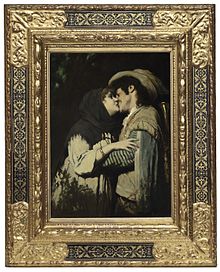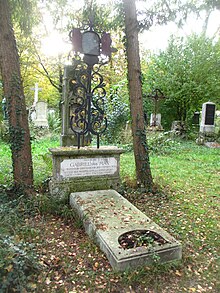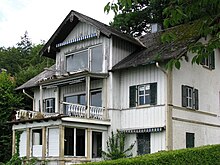Gabriel from Max
Gabriel Cornelius Ritter von Max (born August 23, 1840 in Prague , Austrian Empire , † November 24, 1915 in Munich ; until 1900 Gabriel Cornelius Max ) was a German painter and professor of history painting at the Royal Academy of Fine Arts , Darwinist and spiritualist .
Life
Gabriel Max was the son of the sculptor Joseph Max and his wife Anna Schumann. He received his first artistic training in history painting from his father. At the age of 15 he began a three-year course at the Art Academy in Prague , where he became a student of Eduard von Engerth . Through his recommendation, Gabriel Max was accepted at the Vienna Academy in 1858 . There he was a student under Professors Karl von Blaas , Karl Mayer , Christian Ruben and Carl Wurzinger until 1861 . In 1863 he went to Munich to study with Carl Theodor von Piloty at the Royal Academy of Fine Arts and stayed there until 1867. Through his Munich classmates Hans Makart and Franz von Defregger , he also made the acquaintance of the painter prince Franz von Lenbach .
In 1873 Max married Emma Kitzing in Munich. With her he had a daughter and two sons; the later painters Cornelius and Columbus Max . In 1878 Max was appointed professor of history painting at the Munich Academy; but this office and title he gave back in 1883. In 1884 he joined the Germania Lodge and thus the Theosophical Society , and the founding event of the Germania Lodge also took place in Maxen's house on Lake Starnberg .
In 1893, shortly after the divorce from his first wife, who died in 1929, Max married Ernestine Harlander, also in Munich.
With effect from December 2, 1900 Max was raised to the Bavarian nobility. From about this time on Gabriel von Max lived and looked very withdrawn, mostly in his villa in Ammerland on Lake Starnberg . There he was still in contact with Albert von Schrenck-Notzing and Carl du Prel , whose views and ideas influenced him greatly in his later work. In addition to painting, Max dealt with the anthropology of monkeys. For this purpose he had raised a large herd in Ammerland.
He was one of the preferred selection of contemporary artists that the “Committee for the Procurement and Evaluation of Stollwerck Pictures” suggested to the Cologne chocolate producer Ludwig Stollwerck to commission them with drafts.
His work was determined by the Wilhelminian era themes of genre and history as well as allegorical - mystical picture solutions and spiritualistic- religious motifs, as he, influenced by his friends, was particularly interested in somnambulism and hypnotism . Due to the considerable success that he was able to record during his lifetime, Gabriel von Max is known more for his art than for his collecting. Probably also because his efforts and personal observations in this field did not turn out to be scientific writings.
Gabriel von Max died in Munich on November 24, 1915 at the age of 75.
tomb
The grave of Gabriel Max is in the old southern cemetery in Munich (grave field 23 - row 1 - place 20).
collection
Gabriel von Max's scientific collection comprised more than 60,000 objects that Max had collected since his youth, including one of the largest skull collections of his time. It is divided into the areas of prehistory, anthropology, zoology and ethnography.
It was the artist's wish to leave the collection in Germany after his death and to keep it bundled. However, due to financial constraints, the family soon had to sell them. In 1917, the city of Mannheim succeeded in purchasing the entire collection. In 1935 around 500 objects from the skull collection were sent to the University of Freiburg as part of a collection exchange. After the Second World War it was considered lost. At the end of 2008 it became known that it had been incorporated into another Freiburg skull collection. Max's collection includes skulls from America, Asia, Africa, Oceania and Europe and was acquired by him in the 1870s. He mainly addressed merchants and scientists who were often on the move because of their research. Contact persons were Leo Frobenius , Richard Payer and missionary Andreas Koller. Purchases at the Godeffroy Museum and correspondence with its custodian Johannes Schmeltz are documented.
Max's ethnographic and archaeological collections are now in the possession of the Reiss-Engelhorn-Museums in Mannheim. Parts were in the Darwin exhibition until May 3, 2009 . To see art and the search for the origins . For the first time, three showcases from Max's collection were reconstructed for the exhibition. Parts of the collection were shown from October 2, 2011 to April 29, 2012 in the Reiss-Engelhorn-Museums of the city of Mannheim ( skull cult. Head and skull in the cultural history of man ). On this occasion, numerous skulls are currently being examined for the first time in an interdisciplinary manner using the latest scientific research methods (German Mummy Project Mannheim, Wilfried Rosendahl and University Hospital Freiburg im Breisgau, Ursula Wittwer-Ofen). This exhibition was shown in 2010/2011 in the Kunstbau in the Lenbachhaus in Munich.
Max Villa on Lake Starnberg
To preserve or demolish the listed 1871 built and 1890 by Emanuel von Seidl advanced Max Villa in Münsinger district Ammerland has developed a long-lasting conflict between the owner, the historic preservation authorities and other local residents and interest groups since the early 1990s. In March 2011, the owner submitted an application for demolition, which was rejected by the district administration in January 2012 with reference to the economic reasonableness of a renovation. The International Council for the Preservation of Monuments ICOMOS, part of UNESCO, also protested against the threatened demolition.
Works
The ecstatic virgin ( Katharina Emmerich , 1885)
- other works
- The Anatom (1869) ( Neue Pinakothek Munich )
- Faded (1870) (Oblastní galerie v Liberci | Reichenberg Regional Museum )
- Gretchen on Walpurgis Night (1873)
- The Child Killer (1877)
- Christ awakens the daughter of Jairus (1878) (Musée des beaux-arts, Montréal)
- Saint Elizabeth (1881)
- Monkeys as art judges (1889) (Neue Pinakothek Munich)
- Monkey in front of a skeleton (around 1900)
- Truth Victory (1904)
- The nun in the monastery garden ( Hamburger Kunsthalle )
- Girl cleaning mushrooms ( Städtische Galerie im Lenbachhaus , Munich)
- The Sisters ( National Gallery Berlin )
Namesake
The "Gabriel von Max Monument Prize" of the Protection Association of the Eastern Shore of Lake Starnberg was named after him.
literature
- K. Ehling: Max, Gabriel Cornelius von . In: General Artist Lexicon . The visual artists of all times and peoples (AKL). Volume 88, de Gruyter, Berlin 2016, ISBN 978-3-11-023254-7 , pp. 109–111.
- Constantin von Wurzbach : Max, Gabriel . In: Biographisches Lexikon des Kaiserthums Oesterreich . 17th part. Imperial-Royal Court and State Printing Office, Vienna 1867, p. 165 f. ( Digitized version ).
- Agathon Klemt: Gabriel Max and his works . Society for Modern Art, Vienna 1886.
- Nicolaus Mann: Gabriel Max, a cultural-historical sketch . Weber, Leipzig 1890.
- Franz H. Meißner: Gabriel von Max . Hanfstaengl, Munich 1899.
- Hans Marshall: Gabriel Max. With 8 ill. In: Reclams Universum 26.2 (1910), pp. 1161–1167.
- Johannes Muggenthaler (Ed.): The ghost trains. An exhibition in honor of Gabriel von Max, 1849–1915 . Mosel & Chekhov, Munich 1988, ISBN 3-925987-03-7 .
- Harald Siebenmorgen: Max, Gabriel Ritter von. In: New German Biography (NDB). Volume 16, Duncker & Humblot, Berlin 1990, ISBN 3-428-00197-4 , pp. 457 f. ( Digitized version ).
- Silke Berlinghof-Nielsen, Parapsychological depictions of women in the work of Gabriel von Max . Master's thesis, Heidelberg 1994.
- Harald Siebenmorgen: Gabriel von Max and the Modern Age . In: Klaus G. Beuckers (Ed.): Festschrift for Johannes Langner . LIT, Münster 1997, ISBN 3-8258-3209-0 .
- Karin Althaus, Helmut Friedel (ed.): Gabriel von Max. Painter star, Darwinist, spiritualist. Exhibition Städtische Galerie im Lenbachhaus and Kunstbau Munich (October 23, 2010 to January 30, 2011). Hirmer Verlag, Munich 2010, ISBN 978-3-7774-3031-7 . Exhibition .
- Jo-Anne Birnie Danzker (ed.): Gabriel von Max . Frye Art Museum, Seattle 2011, ISBN 978-0-295-99146-7 .
Web links
- Pictures by Gabriel von Max
- Gabriel von Max; Drawings for Goethe's Faust I
- Special exhibition skull cult. Head and Skull in Human Cultural History October 2, 2011 to April 29, 2012 in the Reiss-Engelhorn-Museums of Mannheim
- Mirja Rosenau: Madonna with Affenkind (Munich exhibition in the Lenbachhaus "Malerstar, Darwinist, Spiritist"), in art - Das Kunstmagazin , October 25, 2010
- Iconic skulls , Süddeutsche Zeitung , WISSEN, October 3, 2010
Individual evidence
- ^ Matriculation database - Academy of Fine Arts Munich .
- ↑ Helmut Zander: Theosophical places: About attempts to keep a secret and to work publicly ( Memento of July 8, 2007 in the Internet Archive ), in: Austrian Journal of History, Issue 4, 2003, page 125, in the Internet Archive on archive .org, as of July 8, 2007, as of July 23, 2010 (PDF)
- ↑ Lorenz, Detlef: Reklamekunst um 1900. Artist lexicon for collecting pictures, Reimer-Verlag, 2000.
- ^ Villa Max: District Office forbids demolition . January 9, 2012.
- ↑ Katja Riedel: Villa Verdruss, in: Süddeutsche Zeitung March 29, 2011
- ↑ Felicitas Amler, Benjamin Engel: Unesco advisors fear demolition of the Max Villa . April 19, 2011.
- ↑ East Bank Protection Association (OSV)
| personal data | |
|---|---|
| SURNAME | Max, Gabriel from |
| ALTERNATIVE NAMES | Max, Gabriel |
| BRIEF DESCRIPTION | German painter and theosophist |
| DATE OF BIRTH | August 23, 1840 |
| PLACE OF BIRTH | Prague |
| DATE OF DEATH | November 24, 1915 |
| Place of death | Munich |










